As aviators, we see no irony in being sustained aloft by an ongoing series of violent explosions of a volatile chemical mixture generating a hearing-damaging roar that calms us to the point of somnolence. Yet when that soothing roar ceases, without our command, and the resulting silence brings us to a level of terrified hypervigilance and frenzied activity, one of the unhelpful recriminations that races through our minds when we should be concentrating on dealing with the emergency is “Why the hell don’t I have an airplane survival kit on board?”
Now is your chance to avoid having such a thought distract you from the process of successfully stuffing your airplane into a safe landing site on the day when all goes wrong, and you cannot convince your engine(s) to continue reciprocating.
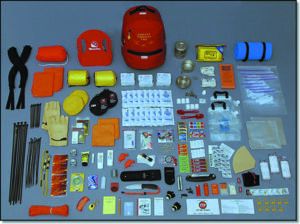
DO IT NOW
Now is the time to put together an aviation survival kit, familiarize yourself with its contents and put it in your airplane in a location where you can get at it easily when most needed. Oh, and it just may be that it’s best to have your survival kit in the form of a vest that you wear so that it’s with you no matter how rapidly you must make a departure from a cabin that is being attacked by a post-crash fire.
We’re going to talk about a small selection of commercially available airplane survival kits that we like. Our survey of some three dozen kits found that a few are outstanding—most suffer from more hype than value. And we’ll say it early and frequently—in the world of survival equipment, value costs money. You don’t want to bet your life on a $30 pocket knife.
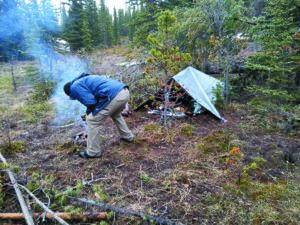
First, recognizing that post-crash survival is a complex subject, we’re going to outline what we feel should be in a survival kit based on long conversations with experts on the subject, attendance at dedicated aviation survival presentations where we could handle the hardware and research into the subject.
YOUR HOMEWORK
We also encourage you to spend time reading the detailed information on aviation survival available at www.equipped.org, written by one of the elder statesmen of aviation survival, Doug Ritter. Full disclosure, Ritter has written for this magazine on aviation survival and other subjects. We note that the website also includes what we consider to be the best study of ditching general aviation airplanes ever prepared—by Paul Bertorelli, Editor at Large of this magazine.
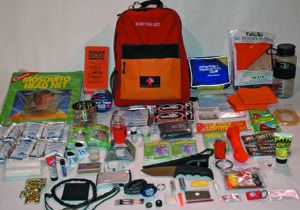
One thing we pilots have our noses rubbed in again and again is that when we try something new, without having had a chance to practice, we do it poorly. Our first landings are measured on the Richter Scale, yet as we relive the experience in our heads and practice, we learn to silk the airplane onto the runway.
It’s the same thing with preparing for post-crash survival: We’ve got to spend time thinking about the subject and then using the equipment we’ve collected—pitch the tent, purify the water, cut something with the cable saw—rather than just toss it in the airplane and hope we can figure it out when we need it—and fate dictates that we’ve only got one working hand. (Um, did I get a signaling mirror and knife that can be used one-handed?) Oh, and some of the survival equipment is perishable—did I update it?
The reason for carrying survival equipment is to stay alive, in the best condition possible, long enough to be rescued after an off-airport landing.
To start with, that means making a flight under conditions where someone will start looking for you soon after you miss your ETA at your destination—which means filing and activating a flight plan, using flight following or arranging with someone to take action to start a search in a given area if you don’t check in by a given time. Hmm, are we currently doing this every time we fly over areas that aren’t reasonably we’ll populated?
It also means having a method of broadcasting to search and rescue (SAR) authorities the fact that you are down, it is an emergency and where you are. That means carrying some sort of emergency locator beacon (your ancient 121.5 ELT won’t cut it). At the least we recommend that your airplane have a 406 MHz ELT and that you trigger it in flight if you are about to make a forced landing. Better is a personal satellite-based emergency transmitter. We’ll look at Personal Locator Beacons (PLB) and other backcountry communication devices in a few months.
We’ll also note that as with aircraft and automobiles, any advertisement that states that an airplane survival kit was designed with no compromises is the worst form of baldfaced lie. Putting together your survival kit requires compromises you must make for the type of flying you do and the type of aircraft you fly—so you will have to make tradeoffs in cost, size and weight.
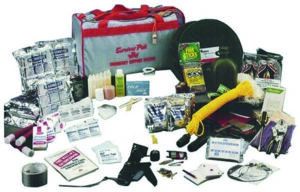
We note that an advertised “military” kit is not necessarily top of the line in the survival world and is often hype. Even if the contents are to mil spec, it’s not unusual for the military to be we’ll behind civilian advances and developments due to the extensive time involved in military procurement.
Often forgotten is that an airplane survival kit should be easy to use and have an understandable manual and list of contents because it is not always going to be used by experts. The kit should minimize the amount of improvisation you have to do post-crash—your workload and stress level is already going to be through the roof.
We’ll do a quick run through the core groups of items that go into a survival kit.
SIGNALING AND LIGHT
Some sort of electronic signaling device that transmits your location is essential (although, to get the most up to date, we recommend it be purchased separately and most of the kits do not include them). Next, a manually operated signaling device to attract attention of those searching for you such as a signaling mirror that can be aimed and seen over 30 miles. We like the Rescue Flash. Prices run in the $20 range (www.diversdirect.com).
For night rescues, a laser flare can be seen over 20 miles. Red is good, green is better. We saw one for $124 at www.greatlandlaser.com. We also liked the various high-intensity personal strobe lights we saw from various sources with prices starting at just over $20.
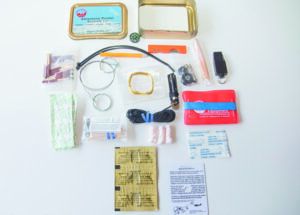
You’ll need to make noise. A powerful whistle is better than shouting. We like the Rescue Howler Whistle—we found them for under $10 for a pack of two on Amazon—one for you, one for your passenger.
We do not recommend pyrotechnics for signaling. We think their time has passed given the effectiveness and longevity of laser and strobe lights—plus, pyrotechnics take up a lot of space, weigh a lot, have limited service lives, last a short time when fired and have caused fires that dramatically increased the risk to their users.
EMERGENCY DEVICES
A high-quality, fixed-blade knife forms the basis of this group. The blade should be four to six inches long for easy use and of steel that is integrated into the handle so it isn’t going to break off the first time it’s used to pry something. This is the last thing you should consider going cheap on when you buy—if you have nothing else when you need to survive, it should be a good knife. It should be backed up by a locking, folding knife that can be operated with one hand. Plan on spending a minimum of $100 for each knife.
This group includes such things as multi-tools, fire starters that will work under virtually any conditions, a stove and fuel, candles, and chemical hand and foot warmers.
SHELTER AND PROTECTION
This varies with when and where you are flying—and a reminder that when it’s cold out, keep your warm coat on when you are flying. If you have to get out quickly, you may never be able to get it afterward.
On a most basic level, large garbage bags—brightly colored, you want to be seen—are effective, inexpensive, compact emergency shelters. Include ponchos, Mylar all-weather blankets and emergency sleeping bags, a lightweight ripstop tarp (essential, in our opinion, due to its flexibility for shelter and warmth). You’ll want insect repellent that is effective against more than just mosquitoes as we’ll as mosquito head nets. Balaclavas are lightweight and warm.
If weight and space allow, a tent is a wonderful to have shelter, even if it is as basic as a tube tent. Make sure that you can erect the tent one-handed, in the dark. Yes, practice with it before you stuff it into the airplane.
Gloves. We’re not kidding. Lacerating your hands is not a good way to start out your attempt to survive. Pack big ones—little hands fit in big gloves but not the converse.
Toilet paper. Again, we’re not kidding—stored in a waterproof container.
WATER AND FOOD
Water weighs a lot, but it’s critical to survival. So much so that if you have food and not water, don’t eat the food: You’ll just increase the rate of potentially fatal dehydration. Before it’s fatal, dehydration also adversely affects thought processes. Figure on an absolute minimum of one quart of water per person per day.
The good news is that there is compact, effective water purification equipment such as the LifeStraw Personal Water Filter, and it’s available for under $20.
There are more survival rations on the market than we can mention. Ideal survival food is long on complex carbohydrates and fats and short on simple sugars and protein. The typical commercial survival kit hard candy is great for a quick energy boost but can be counterproductive if not followed by something more substantial. Jerky—high in protein—requires more water to metabolize, is difficult to digest and is not beneficial for medium-term energy requirements.
Highly concentrated rations provide on the order of 2000 calories per pound and are balanced nutritionally for survival purposes and easily digested with minimal water requirements. Examples are “Mainstay” ($17 for 3600 calories on Amazon), SOS Food Lab (www.sosfoodlab.com), and Mayday food bars ($6 for 2400 calories on Amazon).
Kits may include a metal cup or pot for cooking and melting snow and fishing equipment—watch the quality, it can vary all over.
MEDICAL
This is more than plastic strip bandages for small cuts we saw in too many commercially available kits—it requires serious first aid as we’ll as some degree of trauma treatment, with an emphasis on bandages, splints and the ability to deal with serious bleeding with treatments such as QuickClot.
We think that the medical kit should be in a soft pack to minimize bulk and include such items as meds you take routinely and others that your physician may recommend and prescribe for your survival kit.
Space and weight are the big drivers on emergency medical kits for aircraft. We recommend going as big as possible. We like the kits from Adventure Medical (www.adventuremedicalkits.com) and Wilderness Medical Systems (www.wildernessmedical.com).
MISCELLANEOUS
Survival manual, compass, duct tape, cable or chain saw, safety wire, parachute cord, aluminum foil, zipper lock bags, sewing kit, rubber tubing, waterproof paper, pen/pencil, magnifying lens and carabiners.
ABSOLUTE BASICS
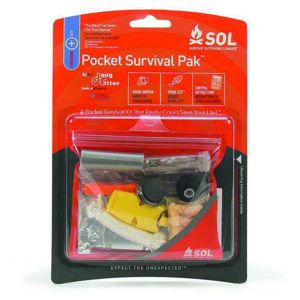
In preparing this article we came up with a “don’t leave the airport without it” list of survival equipment that we recommend a pilot have handy in the airplane: folding knife (quality level of either Benchmade—www.benchmade.com—or Chris Reeve Sebenza—www.chrisreeve.com); Leatherman Charge+TTI (or similar quality and capability) multi-tool (www.leatherman.com); LED flashlight or head lamp; Rescue Howler Whistle (Amazon); two bandannas; cellphone; portable cellphone charger; SOL Fire Lite Fuel-Free Lighter with tinder cord and strobe (www.backcountry.com); DiamondStone pocket knife sharpener (www.wayfair.com); Rescue Flash signal mirror; Go Time Gear Emergency Shelter (Amazon) or Adventure Medical Heatsheets Emergency Blanket (www.fieldandstreamshop.com); mini compass with lanyard that can be used as a zipper pull (Sun Company ZiprComp—Amazon); handheld transceiver (we like Sporty’s PJ2 and Icom’s A25C); and a GPS-equipped Personal Locator Beacon.
KITS WE LIKE
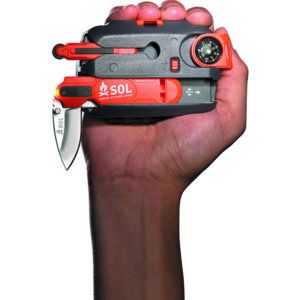
Due to the large number of advertised aviation survival kits, rather than evaluate all that we surveyed, we’ll run through ones that we liked from the high end down.
Current supply chain issues have caused some of the suppliers to temporarily suspend shipping kits.
• Our first selection is the Ultimate Aviator Survival Pak from DougRitter.com. We’ll only touch on some of the equipment included in the 22.6-pound specially designed backpack. Medical equipment includes the AMK Ultralight Medical Kit, Cinch Tight trauma bandages and a splint. The food and water group includes S.O.S. Food Lab Survival Rations, two-liter water tanks, 16 four-ounce water packs, Esbit Wing Stove and fuel tablets, cook set, coffee, tea and bouillon.
For shelter: a silicone impregnated ripstop nylon tarp, poncho, insect repellent, leather gloves, two ultralight bivy sacks, mosquito headnets, two bandanas and two-roll-up sunglasses.
In the signaling group are a Rescue Reflectors mirror, Storm Safety Whistles and a Greatland Laser Rescue with extra lithium battery.
Not surprisingly, the knife in the Pak is top-of-the-line—the Ritter RSK Mk3 fixed-blade. In addition it includes the Leatherman Blast multi-tool.
We reviewed the Pak back in 2015 when it was priced at $2818 and pointed out that quality isn’t cheap. Historically, delivery takes about eight weeks as Ritter prepares several at a time and sends them out with the most recent life-limited components. As we go to press the price is not listed due to difficulties Ritter is having in obtaining some of the specialized equipment. We suggest a call to him at 480-219-7271 to check on the status of kits or to have one customized for the flying you do.
• The Wilderness Aviator Survival Kit from PreparedPilot.com is priced at $595.95 and is designed for two people for “an unexpected night out.” It weighs 16 pounds and is loaded into a bespoke backpack that is 8 x 12 x 16 inches.
We like that the first aid kit is self-contained within the pack and can be accessed on its own. There is also a pocket survival kit that can be pulled out and carried separately if desired. It also has a tag that lists all of the life-limited items to make it easy to ensure that everything is up to date and to set up a tickler system to replace components as needed.
We feel that this is the best airplane survival kit available for under $1000.
• The Canadian-Alaskan Survivor Pak (price about $500 from various sources) is advertised as meeting the Transport Canada summer aviation survival equipment requirements with the addition of a sleeping bag and firearm with ammunition. It includes more food than most of the kits we reviewed—two 14-day rations—and is heavier, at 31 pounds, than some of the more sophisticated kits as it is advertised as being designed to help sustain two people for up to 14 days.
We aren’t particularly crazy about its “hollow handle” knife and heavy, D-cell non-waterproof flashlight. The signaling equipment consists of a steel camping mirror and road flares—we’d rather see at least a strobe light and dedicated signaling mirror. It has space emergency blankets for shelter. We think this kit, while it has shortcomings, is adequate and an example that you get what you pay for when buying survival equipment.
• The Pocket Survival Pak and Pocket Survival Pak Plus were designed by Doug Ritter and are available through various sources at prices around $34 and $55, respectively. We consider these to be the best of the pocket-sized survival kits and we observed that one or the other of them is included in many of the more sophisticated kits we surveyed.
The basic kit weighs 3.9 ounces and includes a 110-dB whistle, the Rescue Flash signal mirror that we like, 10 feet of nylon cord, 15 feet of steel wire as we’ll as a one-hand operable spark light fire starter and tinder. It also contains instructions, 20-mm survival compass, duct tape, aluminum foil, fishing kit, scalpel blade, pencil and note paper.
• The Plus Pak includes everything in the basic Pak and adds an RAK Mk5 survival knife, which is a decent quality, compact steel fixed-blade knife. It also includes an LED flashlight, sterile water bag, water purification tables, 28-inch stainless steel ball chain and waterproof pouch. Weight is 5.9 ounces.
• Best Glide Aviation Survival Equipment (www.bestglide.com) offers its Adventurer Pocket Survival Tin for $33.95. In our opinion, it’s the best of the kits in an Altoid-sized container that we saw. Recognizing the limitations of a 4.5 x 3.3 x 1.2-inch space, it still contains, among other things, a basic signal mirror, fire starters, candles, wire saw, water bag, fishing kit, sewing kit, button compass, whistle and Derma Safe Razor Knife.
• We were impressed by the SOL original survival kit offered by PreparedPilot.com as it is built around a functional case that integrates a Rescue Flash signal mirror into the lid. On the opposite side of the case is a one-handed Fire Lite fire starter and a removable compass. Inside is a compact folding “combination” knife that has an LED light and 100-dB whistle built into the knife handle.
The compact kit also includes TinderQuik fire starting tinder, 100 pound-test nylon cord, steel wire, sewing kit, fishing kit and survival instructions.
Overall, during our survey, we were impressed by the PreparedPilot.com offerings and the information provided on its website.
SURVIVAL VEST
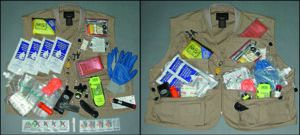
Frustratingly, we found no aviation survival vests offered during our survey. Until recently dougritter.com offered what we considered to be an outstanding kit in a cotton vest for $800. Ritter advised us that as of right now, he is unable to get the cotton vests he has historically used and is testing others to find a replacement. He does not package the kit in a nylon vest because nylon melts and sticks to skin, exacerbating burns, making it hazardous should there be a fire. He told us that he hopes to market survival vests again in the spring of 2022.
Our research indicated that too often a pilot is left with only what she or he had on after egressing from the airplane following a forced landing. In our opinion, that means wearing the equipment is the best way to carry it in the airplane and a vest is the way to carry the most equipment comfortably. We are aware that many pilots are recognizing the risk and wearing nylon vests because they cannot get cotton.
CONCLUSION
When you have to put the airplane down your life may depend on your choice of survival equipment. We think that there is high quality equipment on the market that, with thought and planning on your part, will keep you alive.





